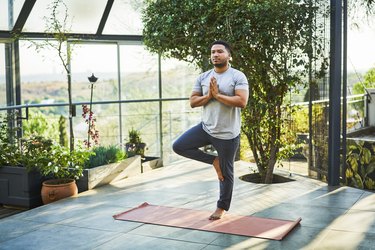
Having a dominant leg is totally normal. Usually, it's related to your dominant hand. So, if you're right-handed, your right leg will be dominant, too. And often, this dominant leg — which, by default, will bear the brunt of your activity — is the stronger of your two lower limbs. This seems, well, super sensical.
What's a little less logical is when you have better balance in your non-dominant leg. If you've ever noticed you're steadier on your left leg even though you're right-handed, for example, it might have you scratching your head and wondering why you wobble more on your dominant side.
Video of the Day
Video of the Day
Here, Sarah Gascon, PhD, a performance coach who has a doctorate in kinesiology, shares the reason behind this counterintuitive phenomenon (spoiler alert: it's a really rational explanation), plus what you can do to achieve better balance in your other leg.
First Things First, What Does the Research Say About Lower-Limb Dominance?
Well, it's a bit inconclusive.
"There have been several studies on inter-limb postural dominance, however they are conflicting," Gascon says.
That's possibly because many factors can affect which leg will be dominant in the balance department.
"There are several variables to be considered, such as previous athletic experiences, activity levels and health history — such as musculoskeletal injuries or concussions," Gascon says.
In addition, the environmental and experimental conditions of the studies themselves will have an effect on the outcomes, she adds. For example, difficulty and specificity of the task, techniques and methods used for measuring balance and the level of expertise of the study participants will all play a role.
So, if these factors aren't consistent, the results won't be either.
Looking to Professional Athletes for an Answer
The reason why you might have better balance in your non-dominant leg may be explained by examining the performance of professional athletes, specifically, soccer players.
Some pro soccer players seem to show better performance on their non-dominant leg, Gascon says. And that might have something to do with the nature of the sport itself.
"Soccer requires monopedal [single-leg] posture to perform different technical movements with the dominant leg while the non-dominant leg is used as a supporting leg," Gascon says.
In other words, players must lean on (literally) the non-dominant leg while they kick or shoot with their dominant leg (which leaves the ground).
In fact, how well a player balances on their non-dominant limb can affect how well they kick with their dominant leg.
"Research has supported that the postural balance on the non-dominant leg could predict kicking performance on the dominant leg," Gascon says.
But why is that? Turns out, it's simply a matter of what is required of each limb.
In soccer, "each leg has a very specific gross motor skill task," Gascon says. "Gross motor skills are defined as foundational skills that involve bigger movements using large muscle groups."
Both balancing and kicking a soccer ball are considered gross motor skills, which can be improved and honed with practice.
Put another way: "Your dominant leg is used for power and accuracy to kick a ball while your non-dominant leg is used to support your body weight," Gascon says.
So, over time, each limb excels at its task, meaning your non-dominant leg will become a bastion of balance.
"Other sports, such as volleyball, handball and tennis, have also shown [athletes] to have better postural balance in the non-dominant [leg]," Gascon says.
But the type of sport isn't the only predictor of postural balance. It also depends on the skill level of the athlete, Gascon says. For instance, "novice or non-professional athletes have shown no statistically significant difference between limbs," she says.
This discrepancy between regular gym-goers and professional athletes might reflect the amount of time pro players put into their training. Remember, professional athletes train for hours a day over the course of many years. So, with time and repetition, each leg sort of "specializes" in its particular function.
What About Non-Professional Athletes?
So, if it's not years of training that contributes to the average person's enhanced balance on their non-dominant limb, then what the heck is going on?
While there's currently no consistent data, "anecdotally, untrained individuals have shown to have better balance on their non-dominant leg because their focus and attention is on supporting the body," Gascon says.
In other words, because we tend to be wobbly on our non-dominant side, we put more effort and concentration into bracing ourselves when using that leg. Hence, ironically, the "weaker" limb ends up feeling more sturdy.
How to Test Which Leg Has Better Balance
Determining which leg boasts better balance is pretty straightforward, Gascon says.
Balance on one leg for 10 seconds and then switch legs. Which limb felt steadier? This is your support leg, Gascon says. And it may or may not be your non-dominant side.
How to Improve Balance in Both Legs
"Understand that your body is asymmetrical and that's not necessarily a bad thing," Gascon says. "However, training and challenging yourself to move in different ways helps improve your quality of life."
You need single-leg balance and stability (on both sides) to perform a plethora of daily activities, such as scaling stairs and stepping over puddles. And although single-leg balance is important at every age, it becomes especially important as you grow older and lose muscle mass and your risk of falls increases.
So, what can you do to boost your balance in your other leg?
"Like anything, having better balance takes practice," Gascon says. "Lifting weights, being physically active and playing sports all contribute to improving balance and proprioception [awareness of the position and movement of your body]," she says.
Specifically, doing unilateral exercises — which challenge one side at a time — and incorporating targeted balance training into your weekly routine can really help you develop better balance in both legs.